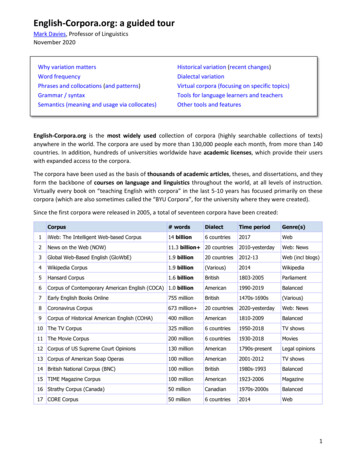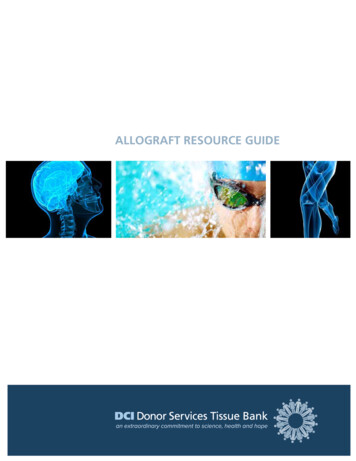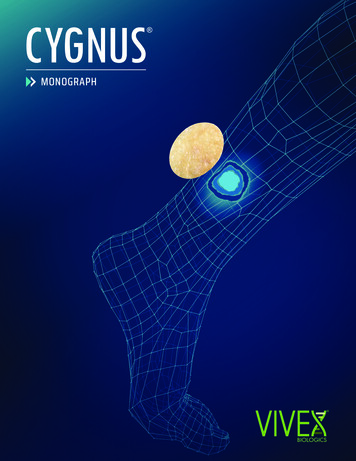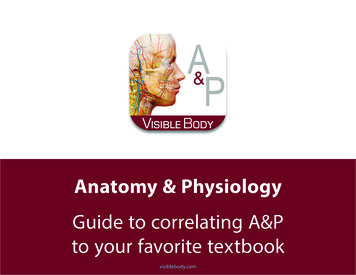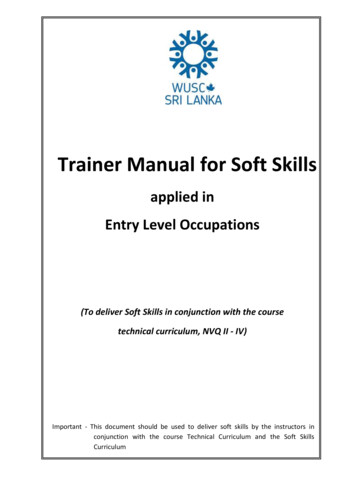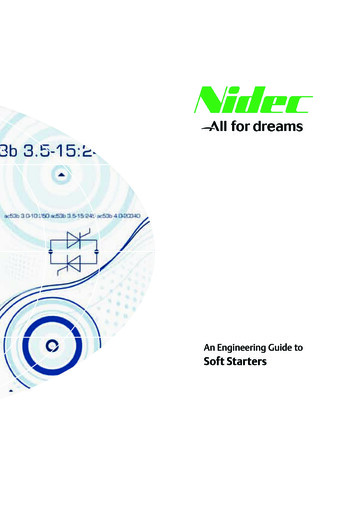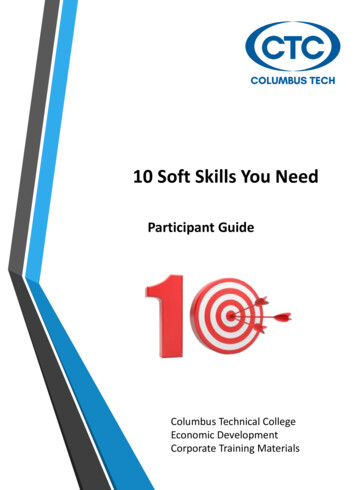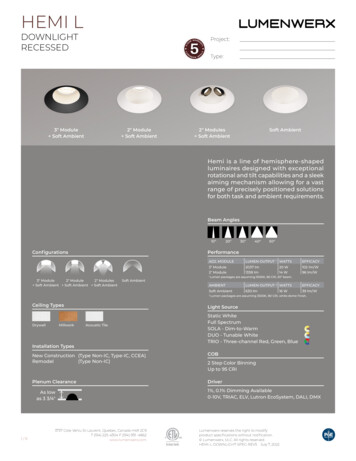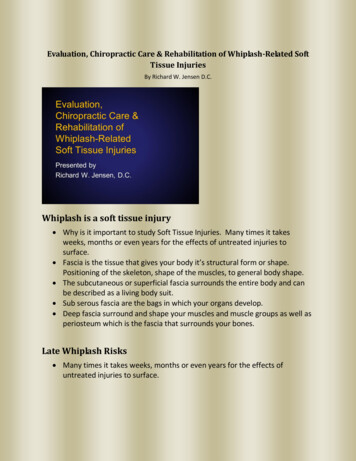
Transcription
Evaluation, Chiropractic Care & Rehabilitation of Whiplash-Related SoftTissue InjuriesBy Richard W. Jensen D.C.Whiplash is a soft tissue injury Why is it important to study Soft Tissue Injuries. Many times it takesweeks, months or even years for the effects of untreated injuries tosurface. Fascia is the tissue that gives your body it’s structural form or shape.Positioning of the skeleton, shape of the muscles, to general body shape. The subcutaneous or superficial fascia surrounds the entire body and canbe described as a living body suit. Sub serous fascia are the bags in which your organs develop. Deep fascia surround and shape your muscles and muscle groups as well asperiosteum which is the fascia that surrounds your bones.Late Whiplash Risks Many times it takes weeks, months or even years for the effects ofuntreated injuries to surface.
Type 1 Whiplash Injury Characterized by stiffness and discomfort.No ROM loss nor Dermatome lossCranial Nerves fineNo nerve traction problems (i.e. HA, dizzy)Compression tests normalLoss of motor unit alignment as well as fixation. (Subluxations found)X-ray findings: NormalType 2 Whiplash Injury Palpable tenderness and muscle guardingNo ROM loss nor Dermatome lossCranial Nerves fine nerve irritation resulting in headaches, dizziness and lightheadednesslimited to the first week Mild instability Mild to moderate muscle spasm X-ray findings: hypolordosis
Type 3 Whiplash Injury Swelling, Spasm, Loss of ROM in all planes, nerve injury with deficit for 7-10 daysModerate signs of instabilityRadiculopathy w/o motor or DTR loss.Abnormal orthopedics findingsEvaluate for cervical disc and TMJX-ray findings: Soft tissue swelling, No osseous abnormalities.Type 4 Whiplash Injury Pain, Spasm, Severe restriction of ROM in all planes, nerve injury with head, face and eye disturbancesModerate to severe instabilityDisc, joint and soft tissue injuryUnilateral or bilateral radiculopathyorthopedics produce severe generalized pain and spasmX-ray findings: Soft tissue swelling, Need to rule out ligamentous disruption,fracture, and anatomic subluxation (anterior vertebral translation).Type 5 Whiplash Injury Severe spinal trauma, disc herniation with fragmentation commonLoss of motor function commonMyelopathy and spinal cord compromiseMultiple injury sites often with deformityX-ray findings: Ligamentous instability on Lateral films, Fracture or facetdislocation possible, Immediate follow up with advanced imaging to ruleout occult fractures, disc injury, spinal cord compromiseAdvanced Imaging Neurological signs and symptoms? Suspect disc involvement? Consider advanced imaging or electrodiagnostic testing.
The Bone marrow response in this picture shows a fresh injury and physiologic change that will notappear on plane films.Late Whiplash Risks Female d/t greater head to neck mass ratioRear vector vs. other vectorsBody mass indexUse of seat belt/shoulder harnessRib, breast, shoulder, abdominal injuriesInitial acute localized back pain that becomes chronic.Loss of cervical, thoracic, lumbar, extremity range of motionHyper/hypomobility of injured jointsCervical, Thoracolumbar back pain spreadsExtremity pain, radiculitis, weaknessSoft tissue instability if not properly treated.Cognitive dissonance, anxiety, depressionDecrease in EndorphinsDrugs, exercise, therapies help lessGreater number of initial symptomsGreater severity of initial symptomsHigh initial pain intensity
Neck, back and extremity pain on palpation and range of motion testingNeck painMuscle painVisual disturbancesSleep disturbancesRadiating pain in lower extremitiesSpinal subluxationsMuscle spasms, rigidity, fixationsHeadachesArthritisDisc degenerationForaminal stenosisHypolordosisFront seat-driver seat vs. passenger seatFemalesRear seat passengerOccupants of vehicles manufactured late 1980’s - early 1990’sDrugs Mask symptoms Allow untreated injuries to develop intochronic degenerative problemsphysical disabilitiesemotional disabilities
#1 Document A Reason For The CareEvaluation of Whiplash Related Soft Tissue Injuries This always begins with the case historyincluding: Chief complaint History System Review Medical history Family history Occupational history Social/lifestyle historyExamination Examination starts with inspection during the history taking. (In my casethis begins by directing the patient to the exam room. Then observing theirgait while following them down the hall.) The doctor should visualize the following: Patient’s body type Posture Swelling Bruising Etc.
Posture A great deal of information can be gleaned from analyzing the patient’sposture. (Take Pictures) A great synopsis of posture analysis can be found in AK texts.Walther’s “Synopsis”, Stoner’s “Eclectic Approach to Chiropractic”, Thie’s“Touch For Health”. Analysis of the posture give you a list of possible weak muscles.Postural DeviationEars not levelShoulders Not LevelHips not levelShoulders rotatedHead level but rotatedPelvis twistedHands rotated mediallyHand held away from the bodyLordosis, belly hanging out or sway backKyphosis, belly curved in or back curved outPossible Muscle WeaknessNeck Muscles, Rhomboids, Sacrospinmedius, upper trapezius.latissimus dorsi, neck muscles, Gluteutrapezius, deltoids.Psoas, Adductors, Gluteus medius.Levator scapulae, Latissimus dorsi, RhRhomboids, Abdominals, Trapezius, sPsoas, tensor fascia lata, Sartorius, AbTeres minor, PsoasGluteus mediusAbdominals, Piriformis, PsoasSacrospinalus, Psoas
Bowed kneesKnock kneesKnees hyperextendedForward leanSideways curves of backAnkle pronated or flat feetFoot turned inFort turned outBowed achillesDifficulty placing hands behind backAdductors, tensor fascia lata, GluteusGracilis, Sartorius.Popliteus, gastrocnemius, QuadracepSoleusAbdominals, sacrospinalis, latissimusPsoas, anterior tibialis.Psoas.Adductors, hamstrings, peroneus, psoPeroneus.Trapezius, upper trapezius, Teres majDeltoid.Difficulty raising armSerratus anterior, rhomboids, levatordeltoids, Abdominals, Supraspinatus,Pectoralis major Clavicular. These muscles will almost always have a quality of hypertonicity (contraintuitive), and soreness due to possible swelling, guarding, injury, spasm,and etc. Also check the reactive muscle groups for strength, soreness,spasm, etc.I personally take pictures to show patient’s their own posture deformities, thesepictures are from the front (Anterior to Posterior), Back (Posterior to Anterior)
and Side (Lateral) aspects as well as comment (take notes or record) a live analysisfrom three perspectives front, side, and spinal view (looking down the spine,which is up close, I can imagine they can feel my breath on the back of their neckon this one) viewing the torsion of the pelvis to the heels, and shoulders to thepelvis.Presentation of posture pictures for you and your patient, first by grid makinganalysis easier.Second spell out the posture distortions with lines drawn.
Some examples of posture problems are present on the slides below, as anexercise you may cover the right side of the slide and then using the table ofposture deformities to muscles you can compare your answers to mine,remember that this then becomes a list of possibilities for which you will test thestrength of the muscle and palpate that muscle to document other qualities suchas strength, tone and tenderness.
Second Posture distortion.Third Posture distortion
Feet are also powerful indicators of muscle weakness and posture distortion, justask “Footlevelors Inc.”. Fallen arches can be powerful indicators further up theleg, pelvis and torso.Such as in this man, pronation of the right foot can indicate imbalance betweenthe hip external and internal rotators (piriformis, psoas), affecting the quadratuslumborum, abdomen, adductors, gluteus medius, opposite tensor fascia lata, thesacrospinalis, the suboccipitals, medial collateral ligament, rhomboids, levatorscapulae, sternocleidomastoid, scalenes, etc. This gives you a global view of howthe body communicates with the floor into the function of movement andstanding. Start palpating with these muscles in mind and you will learn volumes.Work these muscles with myofascial release, muscle energy techniques,stretching, and you will see distortions change before administration ofchiropractic adjustment.
Spasm of the sacrospinalis or psoas as an example with shorten the ipsilateral sideas the torso has a concave posture to that side by muscle distortion.See the gluteal distortion on this picture as well as the scoliotic convexity to thecontralateral side of the short leg. This is a mechanism of compensation whenthe patient is standing, and muscle memory keeps it there while lieing prone.
Check the relative sizes of the red and green boxes on these next two pictures.The legs are being relaxed into interanal rotation of the anterior thigh. Thedifference represents the relative tone of the piriformis (external rotator) to thepsoas (internal rotator).
Inflammation and postural changes Release of vasoactive mediators sensitize and irritate nerve endings causingpain. Pressure from edema on nerve endings cause further pain.
Pain causes a withdraw reflex which reduces the function of surroundingstructures.Example of Postural Changes Painful low back causes person to bend back and slightly to that side torelieve stretch/pressure. The prolonged change to posture sets up local muscle spasm. Spasmed muscle automatically relaxes muscle tone of antagonistic muscles,which are hip flexors and abdominal muscles.Palpation/Testing Describe what you are doing.Keep the patient’s modesty intact at all times.Use tissue barriers (i.e. the patient’s own hand)Have same sex person in the room, particularly when examining “at risk”people and/or anatomy. Reactive muscle groups may be defined as the Contra lateral muscle, primemover, synergist, antagonist, and fixator muscles. Another useful list to know. Patient’s become convinced of expertise dueto you knowing where they hurt, because you do. Even points they did notknow hurt in the first place.Reactive muscleSedation requiredNeck flexorContra lateral PsoasSplenius CapitusContra lateral PiriformisUpper trapeziusLatissimus dorsi, biceps, Contra lateral upper trapeziusDeltoidRhomboids, Pectoralis minorSupraspinatusRhomboids, Pectoralis minorRhomboidsDeltoid, Serratus Anterior, SupraspinatusLatissimus dorsiContra lateral hamstring, upper trapeziusPectoralis minorSerratus anterior, Supraspinatus, DeltoidPectoralis major (Clavicular division)Gluteus Maximus
Serratus AnteriorRhomboids, Pectoralis minorBicepsTriceps, upper trapeziusTricepsBiceps, supinatorSacrospinalusTransverse Abdominals, Gluteus Maximus, hamstringsDiaphragmPsoasRectus AbdominalsQuadraceps, Contra lateral Gluteus mediusUpper Rectus AbdominalsLower Rectus AbdominalsLower Rectus AbdominalsUpper Rectus AbdominalsTransverse AbdominalsSacrospinalisPsoasAdductors, Contra lateral anterior neck flexor, diaphragmReactive muscleSedation requiredGluteus mediusContra lateral Rectus AbdominalsPiriformisContra lateral splenius CapitusGluteus MaximusSacrospinalus, Pectoralis majorHamstringsSacrospinalis, Contra lateral latissimus dorsi, Quadraceps, Popliteus.Tensor fascia lataAdductors, Peroneus tertiusAdductorsTensor fascia lata, psoas.QuadracepsGastrocnemius, hamstrings, Rectus Abdominals, SartoriusSartoriusTibialis anterior, QuadracepsPopliteusGastrocnemius, hamstrings, upper trapeziusGastrocnemiusPopliteus, QuadracepsTibialis AnteriorSartoriusPeroneus tertiusTensor fascia lataGluteus mediusContra lateral Rectus AbdominalsPiriformisContra lateral splenius CapitusGluteus MaximusSacrospinalus, Pectoralis majorHamstringsSacrospinalis, Contra lateral latissimus dorsi, Quadraceps, Popliteus.Tensor fascia lataAdductors, Peroneus tertiusAdductorsTensor fascia lata, psoas.
QuadracepsGastrocnemius, hamstrings, Rectus Abdominals, Sartorius
Examination Initial lateral cervical neutral scout film, this is to identify any instabilities. Ifinstability is found refer to hospital immediately. If no instability is found
then the examination should continue with remainder of Davis X-ray series(I would also include open mouth lateral flexion films) orthopedic, neurological and physical examinations
Cervical Spine This is the most vulnerable part of the spine due to being the part with thegreatest flexibility.
Pain from Cervical Injury Lateral neck Suboccipitals Shoulders Mid thoracicNote: Worse with range of motion.Deep Palpation finds EdemaPoint tendernessMyospasmNodulesAdhesionsTrigger pointsTissue Effected Muscle weaknessFull passive ROM, Limited active ROM Muscle Strain/SprainPain with resisted ROM LigamentPain with passive ROM
This is a common pattern of referral neuropathy with whiplash.Muscles Normally Involved SuboccipitalsScalenesLevator ScapulaeSplenius CapitisPrimary Ligaments Involved Anterior Longitudinal Ligament Posterior Longitudinal Ligament Interspinous Intertransverse
Acute Care Pain felt at restPain is generally diffuseAggravated by activityMovements restricted by guardingAcute Care Goals Promote Rest Reduce Muscle SpasmMuscular Pain that changes posture, or movement.Tenderness Pain upon palpation Reduce Inflammatory Reactions Reduce pain to tolerable levels Increase overall functionProgress May Be Slow Due To Previous Injury Anomalies (Asymmetrical facets, congenital fusions, cervical ribs) Degenerative conditionsCorrective / Active Care Little to no pain at rest Pain is generally localized Increased pain with activityCorrective / Active Care Goals Further reduction of symptoms Further increase function To return patient to pre-injury status
Prognosis Time Pain less than 8 days – prognosis not delayedPain 8 days – prognosis time delayed 1.5 timesMild pain – prognosis not delayedSevere pain – prognosis time doubledRepeat Condition up to 3 times – no delay4th repeat and higher – prognosis time doubledTreatment Protocols Reassurance that condition is self limiting, within 4 years.Anti-inflammatory agentsROM exercisesReturn to normal activitiesReassessmentFurther note on “Self-limiting.” There is research contrary to this that states thata whiplash type injury has been positively correlated with the development ofMultiple Sclerosis and Parkinson’s when left untreated.
Long Term Symptoms 15 years after injury80% of women continued to experience neck and back pains50% of men continued to experience neck and back pains 10 – 15 years Tinnitus and back pain increased Static Symptoms54% remained static28% worsenedLong Term Results of Untreated Whiplash Injuries Chronic back and neck painsHeadaches/lightheadednessLoss of spinal ranges of movementSpinal scoliosisDegenerative disc diseaseSpondylosis (spinal arthritis)Loss of heightHypolordosis
Degenerative Changes 100% of patients who had experienced whiplash injuries exhibiteddegenerative changes in the spine and spinal discsCalm The Inflammatory ResponseTreatment Protocols PRICE acute,Ice 10-15 min on, 30 min off, 10-15 on, etc. Massage – Very gentile or wait 2 days.Too much may cause inflammation Adjust – the sooner the better.DistractMobilizeIf pain on setup, Stop!, use activatorCyclo-oxygenase, a primary enzyme involved on inflammatory processes, isincreased by antibiotic use as well as insulin, therefore by refined carbohydratesand high fructose corn syrup.
The result of uncontrolled PgE2 such as pain and free radicals leads us down thepath of increased risk for cancer, arthritis, and atherosclerosis. Therefore some ofthe delayed complications of a whiplash injury.See the video “Inflammation and the Joint.mp4”Treatment Protocols Chiropractic Adjustment and adjunctive therapies. EMS, Ultrasound, Acupuncture, Heat, Ice. ExercisesTo restore motion, functional improvement.ROMPNFDocument Treatment Rehabilitation is indicated if patient hasSwellingSpasmLoss of ROM. DocumentGood records helps your memoryFunctional issuesAspects of lifeWhen patient has a plateau, you can remind them of how they haveprogressed.Chiropractic care of Whiplash Related Soft Tissue Injuries Soft tissue therapies prepare the spine and joints for the chiropracticadjustment. Muscles have their best leverage when the bones are in correct alignment. Muscles that cannot function at full strength create a constellation ofmuscles that will become weak, hypertonic, and sore. (ex. supraspinatusdeltoid)
Myofascial Release A close relative of massageManual contact with patientBoth use sense of touch to evaluateBoth use pressure and tissue stretch to produce results.Same Principle, Many Names Myofascial ReleaseMyofascial StretchingStrain-counterstrainRolphingSoft-Tissue MobilizationAssessment in Treatment Continuous palpation performed throughout treatmentTissue extensibilityMovement
End-feelResponse to treatment The response is tissue giving-way, letting go, relaxing, or melting. Normal tissue has no tenderness when palpated, a springy end feel whenreleased.Application of Myofascial Release Superficial to DeepLeast amount of force that meets goalsAssess patient’s tolerance before going deeper.The body is like a child in that you must show it you mean no harm.Otherwise involuntary guarding may occur. Doctor and patient should be relaxed, for Doctor the result is betterpalpation / assessment. General GuidelinesStart by no more than 3-5 minutes per areaBruising should never result from this treatment, too heavy of pressure, thisleads to new or greater adhesions.Myofascial Release Techniques General Technique (support and stretch) J-Stroke for scars Oscillation Wringing“Grip and rip” Strippingslow, constant, and deep Arm Pull and Leg PullLong Axis Distraction with a twist until releaseMFR precautions New scars reduced tensile strength Reflex Sympathetic DystrophyPain exacerbates, thus be gentile Bruising should never occur
Pain, burning, tingling and warmth may be felt with this technique, informthe patient to inform you if there is any other sensations.MFR Contraindications MalignancyHypermobile JointsRecent FracturesHemorrhagesSuturesOsteoporosisLocal InfectionsAcute InflammationMuscle Energy Technique Find Restriction Resist Patient into smooth contraction of muscle and ROM through 5seconds Then stretch into opposite movement of muscle gently until relaxation /release takes place. Muscle testing is the diagnostics as well as the technique.
Proprioceptive Neuromuscular Facilitation (PNF) Multiple feedback to patient to coordinate correct motor neuron firing.Hands on patients extremity (arm, leg, head)Patient ability to see the motionDoctor’s verbal cueing Patterns of MovementCNS stimulation results in mass movement patterns, not straight planeDiagonal with a pivotPNF: Diagonal with a pivot Three Components Diagonal Movements IncludeFlexion / ExtensionAbduction / AdductionAway and Across the MidlineAbductionToward and Across the MidlineAdductionRotation
Medial or LateralPNF: Principles (Voss & Knott) Clinician’s hand placement for providing appropriate facilitation of touchand pressure receptors. Verbal 1 to 2 word cues in moderate tone“Push”, “pull”, “hold”, “relax”, “rotate”, “across” No pain Proper InstructionSequence of activitiesDiagonal patternAppropriate Speed Rotation is important componentMuscle chain from distal to proximal Providing Resistance to movement provides traction and compression tojoint surface and therefore stimulation to joints. A quick stretch used before initiating movement, stronger initial reaction. Contraindicated in some acutes, use judgment. Motions are precise and smooth Proper Body Mechanics should be usedPNF: Techniques StretchingHold – relaxContract – relaxSlow Reversal hold – relax StrengtheningRhythmic initiationRhythmic stabilizationSlow reversalSlow reversal - hold
Strengthening Principles Specific ExercisesNo PainAttainable GoalsProgressive OverloadRehabilitation Restore strength Improve endurance Improve function to pre-injury statusRehabilitation Includes Therapeutic exercise Activities of Daily Living training Active Range Of Motion (ROM) exercisesSee Video entitled “Rehabilitation of Neck Tour.mp4”
Finally Document Treatment And Put It All Together
Sideways curves of back Abdominals, sacrospinalis, latissimus dorsi. Ankle pronated or flat feet Psoas, anterior tibialis. Foot turned in Psoas. Fort turned out Adductors, hamstrings, peroneus, psoas, Gracilis. Bowed achilles Peroneus. Difficulty placing hands behind back Trapezius, upper trapezius, Teres major, anterior Deltoid.

